My shopping cart
Your cart is currently empty.
Continue Shopping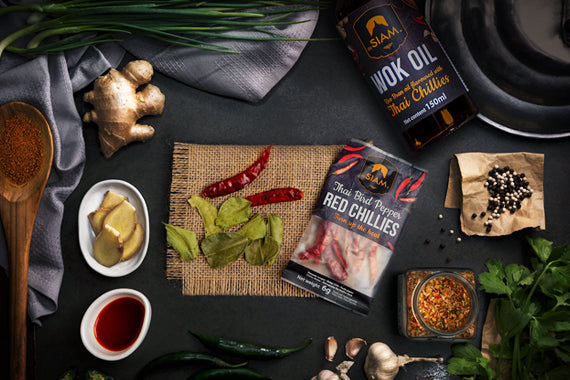
Cooking Thai food is not as difficult as you may think and by learning more about it’s the herbs and spices, curry pastes and seasoning, can help you achieve the result that you’re looking for.
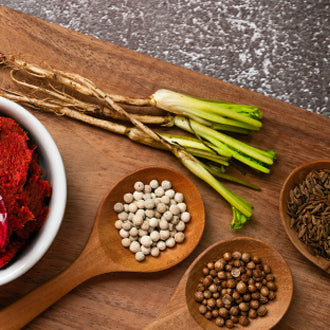
Coriander Root: Coriander root is essential and extensively used in many Thai dishes, Thais use it as the base for soups, curries, stews and as a mixture for marinade. Local people will often grind or pound the root in a mortar before use to release the flavor and aroma, or to make a paste.
Coriander Seeds: Coriander seeds give an earthy and nutty flavor and a unique aroma which make them a great marinade for red meat. Also it is used as the base in various types of curries, including Panang and Massaman.
Cumin Seeds: Cumin seeds have a distinctive flavor and aroma. In Thai cuisine, the seeds are an essential part of red, green, and yellow curry. Cumin seeds can be used ground or as whole seeds, but Thai people like to roast and pound them before mixing with curry paste to enhance the flavor and aroma.

Fresh Chilies & Dried Chilies: Chili is one of the most popular ingredients used in Thai cooking and there are many varieties of chilies with different levels of hot and spiciness, such as bird's eye chili, chili spur pepper, bell pepper. Thai people use chili, both fresh or dry, on nearly everything, from salads, curries, soups, stir-fries, or dipping sauces as well as add it in their food for some extra kick.
Garlic: Garlic is used intensively in Thai cuisine, from stir-fried, soup bases and curry pastes, or deep fried and used as a topping for several dishes. Besides that, garlic is also popular to eat raw with fatty foods and used raw in many dipping sauces and salad dressings as well.
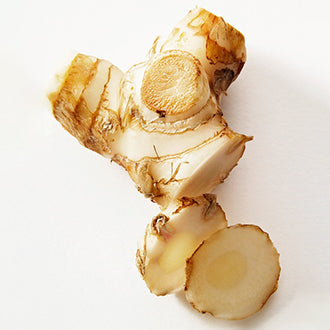
Galangal: Galangal rhizomes are used in various traditional Thai cuisine from curries, soups to salads, the best sample is Tom Kha Gai (coconut chicken soup). Galangal is not typically eaten as a standalone, but it is used to add scent and flavor to dishes. The root plant is related to ginger, which is why they look similar, but their tastes are very distinct from one another, so don’t get them confused as one cannot be used as a replacement for the other.
Ginger: Ginger is commonly used in many Thai stir-fries, traditional snacks, steamed fish or seafood, a topping in congee, and Chinese vinegar-based sauces, whilst many of these dishes are borrowed from Chinese cooking. You will find ginger in many steamed fish or seafood dishes and dipping sauces since ginger can reduce the fishy smell from fresh seafood.
Holy Basil: Holy basil or Thai Basil gives a distinctive scent of clove and reddish tipped leaves. It is a staple base of the famous Thai stir-fry dish ‘Pad Gra Prow’ (minced meat stir-fried with Thai basil). Thais also make another creation ‘Gra Prow Grop’ which is made by deep frying the leaves before sprinkling them over the food which gives a crispy texture and different feeling to the Gra Prow dishes. Thais also use fresh basil leaves on top of soup or curry to add extra aroma to the dishes.

Kaffir Lime Leaves: One of the most popular ingredients and widely used in Thai cuisine, from curries, salads, soups, to stir-fries. Thais also use the kaffir lime leaves with steamed seafood to reduce the fishy smell and enhance the citrus aroma. The leaves are edible, but many Thais do not eat the leaf itself unless it is sliced very thin for recipes like Tod Mun Pla (Thai fish cake) or Choo Chee and Panang curry.
Lemongrass: Lemongrass is another herb commonly used in many Thai cuisine for marinades, stir-fries, salads, spice rubs, and curry pastes. Thai people use the lower portion of the stalk of the lemongrass and typically cut or chop it up prior to cooking.

Thai curry paste is a unique blend of spices of different kinds. Most pastes share the same recipe using aromatic herbs and spices like cumin, chilies (fresh or dry), galangal, lemongrass, red shallots and garlic. Other ingredients such as kaffir lime lives or zests, coriander roots or shrimp paste can be added to make the paste different. In Thailand, pastes are traditionally made by pounding and mixing many herbs and spices together with a pestle and mortar. Now many Thai chefs still prefer to use the old method since they believe the paste can offer more an aromatic and flavorful taste. However, now a food processor is more convenient choice, and the ready-made Thai curry paste is surely a life and time saving product, especially for beginners.
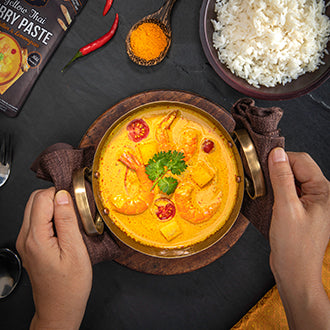
Thai curry pastes typically have three colors: red, green, and yellow. These colors are not simply for aesthetics, they usually tell us what these pastes taste like. Red curry paste is bright and heavily spiced with dried red chilis. Green curry paste is made with bright green Bird’s Eye Chili Pepper but green curry paste is known to be the most sizzling curry paste of all. Lastly, yellow curry pastes get their color from turmeric and Indian-style yellow curry powder, so they are the least spicy of the three.
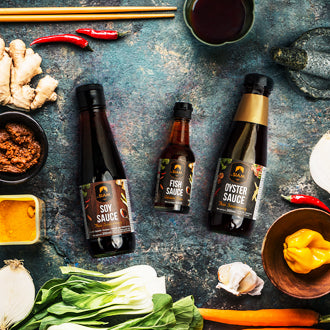
Fish Sauce: Fish sauce in Thai is called Nam Pla. It is a staple condiment used in Thai cuisine to provide some saltiness. Fish sauce is made from fish coated in salt and fermented for up to two years. Fish sauce has a salty, briny and savory flavor but also contains a distinct, pungent smell as well. The sauce is universally used to season most Thai main dishes, from soups, salads, curries, stir-fries, dips to marinades.
Light Soy Sauce: Light soy sauce or thin soy sauce is called Si-Ew Khao in Thai. It is made from soy beans, salt, and sugar. The soy sauce is somewhat translucent and a light reddish-brown color and has an umami flavor with moderate saltiness but doesn’t contain a strong pungent smell like fish sauce. This type of soy sauce is used widely in Thai cuisine, you can add a few drops of soy sauce to enhance the flavor of the dishes. Even the soy sauce taste is different from fish sauce, but you can substitute fish sauce with thin soy sauce in any vegetarian dish.
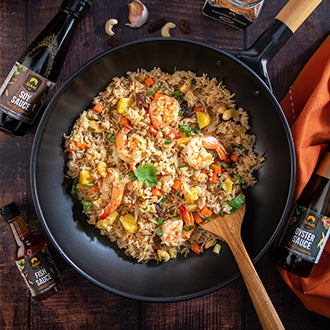
Oyster Sauce: Oyster Sauce is called Sauce Hoy Nang Rom in Thai. It has a distinctive salty, umami taste which is not fishy like fish sauce. Oyster Sauce is made from oyster extractive, sugar, water, salt, corn starch and wheat flour which made the sauce thick and viscous. It is mostly used to season stir-fried vegetables, meat, seafood, noodle dishes and a dipping sauce.